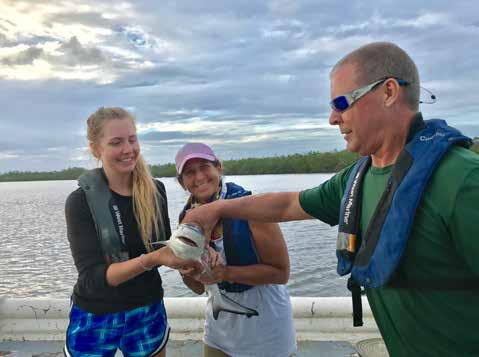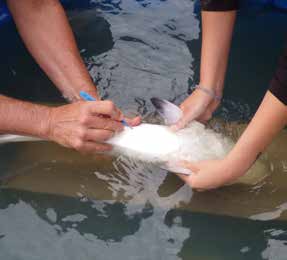Artemis and the Secrets of Shark Survival
 May 22 was the last evening of sampling for the month. In Fakahatchee Bay, Pat O’Donnell, a fish biologist at Rookery Bay Research Reserve, and his team of volunteers caught only one shark, but that small newborn bull shark was the one he was hoping to find.
May 22 was the last evening of sampling for the month. In Fakahatchee Bay, Pat O’Donnell, a fish biologist at Rookery Bay Research Reserve, and his team of volunteers caught only one shark, but that small newborn bull shark was the one he was hoping to find.
As his study area is directly affected by hydrologic restoration in the Ten Thousand Islands watershed, O’Donnell has been working to determine if newborn sharks caught in bays with higher salinity levels will eventually seek out lower salinities associated with the altered freshwater flow coming from the Faka Union canal, where, each year, millions of gallons of fresh water are diverted across the land to the Gulf of Mexico.
This study began after a paper published by Mote Marine Laboratory in Sarasota described how the youngest, smallest bull sharks in a study were found farther up the Caloosahatchee River in the lowest salinities. They couldn’t, however, state where these sharks came from, or where they were pupped or born. Through his studies, O’Donnell is attempting to prove that newborn bull sharks can find the lowest salinities, and will stay there to avoid being preyed upon by larger juvenile bull sharks that tend to stay in moderate to higher salinities.
That May evening, the newborn bull shark was swimming in circles in a five-foot-wide kiddie pool onboard the boat while O’Donnell’s team prepared to perform acoustic tagging surgery. One of his most
enthusiastic volunteers that night asked if she could assist and O’Donnell agreed, letting Kennedy Vertin, an undergraduate at the University of South Florida in Tampa, hold the shark upside-down in the pool while O’Donnell made a small incision in the belly area.
He inserted the acoustic tag and put in three stitches to close the opening. Meanwhile, another volunteer held a bilge pump in front of the shark’s mouth to keep water flowing into the mouth and over the gills. This technique worked well, and the shark continued to swim circles in the pool after surgery.
Just before the newborn was released into Fakahatchee Bay, O’Donnell asked Vertin if she’d like to name the newly tagged bull shark. She suggested Artemis, the name for the Greek goddess of the wilderness. He let Kennedy get a photo holding Artemis just before gently releasing her into Fakahatchee Bay.
After tagging and releasing her, there was no evidence of her movements until the following day.
 Data from the acoustic receivers showed that on May 23 at 9:30 a.m., Artemis made an appearance in Faka Union Bay. She wandered all around the bay, pinging off many of the 16 receivers O’Donnell had placed within the Ten Thousand Islands study area. On May 24, at a low tide, the receiver data showed that Artemis found the Faka Union tidal creek leading up to the dredged canal that feeds the bay with freshwater.
Data from the acoustic receivers showed that on May 23 at 9:30 a.m., Artemis made an appearance in Faka Union Bay. She wandered all around the bay, pinging off many of the 16 receivers O’Donnell had placed within the Ten Thousand Islands study area. On May 24, at a low tide, the receiver data showed that Artemis found the Faka Union tidal creek leading up to the dredged canal that feeds the bay with freshwater.
She stayed within the canal/tidal creek for 44 days until July 7, when – during a low falling tide – she re-entered Faka Union Bay and stayed there until the salinity reached about 22 ppt (parts of salinity per thousand parts of water) on a rising tide, and then re-entered the tidal creek. For the next 18 days, Artemis swam around Faka Union Bay and was recorded on just about every receiver within the bay. From July 25 through July 30, she was found in the dredged canal again.
For less than one day on July 30, she swam around the bay before again returning to the canal for the next 21 days. This is as far as the story goes for now, as the complete dataset from late August onward has
yet to be downloaded. It’s hoped that this is just the beginning of her story, as O’Donnell’s tags are
supposed to be capable of transmitting data for more than nine years.
Vertin was provided the tag and receiver data for Artemis, as well as the salinity data from the area,
to help track the shark’s general movements and correlate them with the salinities levels that were changing due to tidal and canal flows. She’s using her newly acquired GIS skills to produce a pictorial view of where Artemis traveled and when. It’s up to Artemis to swim by some more acoustic receivers when she can, providing more secrets of her survival.
Rookery Bay National Estuarine Research Reserve is managed by the Florida Department of Environmental Protection in cooperation with NOAA. Now celebrating 40 years, the reserve protects 110,000 acres of coastal lands and waters between Naples and Everglades National Park. Learn more at www.rookerybay.org or www.floridadep.gov/fco.



Leave a Reply
Want to join the discussion?Feel free to contribute!